Trochanteric Bursitis: Bursitis of the Hip aka Greater Trochanteric Pain Syndrome
A "bursa" is a sac that contains fluid and allows soft tissue (muscles, tendons) to glide more easily over bones.
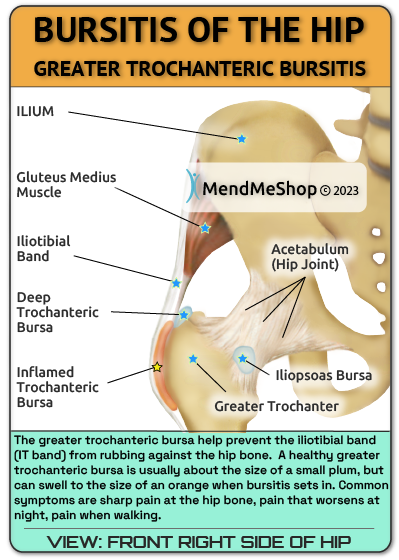
Interesting Stats about Trochanteric Bursitis
Trochanteric Bursitis is Responsible for Approximately 60% of Hip Bursitis Cases in North America. Trochanter bursitis is the term used to describe chronic, intermittent pain accompanied by tenderness to palpitation at the lateral aspect of the hip (outer portion of the upper thigh, either left or right side).
There Are a Total of 9 Bursae on the Outside of Your Hip
The trochanteric bursa is one of them but there are many others that could be the source of your pain.
Trochanteric Bursitis Affects Women More Than Men
Trochanteric bursitis affects approximately 15% of women and 8% of men. Trochanteric bursitis most commonly occurs in middle aged women.[4] Trochanteric bursitis can occur in female athletes of all ages.
About Greater Trochanteric Pain Syndrome (GTPS)
GTPS has become a term more commonly used than trochanteric bursitis as it has been shown that inflammation of the trochanteric bursa is not always present in patients with pain over the greater trochanter muscle. GTPS is basically used to describe common symptoms such as pain and inflammation in the outer upper thigh which may correspond to tendonitis, bursitis, a tear in the gluteus medius muscle or a combination of any of these injuries. It is estimated that GTPS affects between 10% and 25% of the population in industrialized societies - however, keep in mind that trochanteric bursitis does not occur in all GTPS cases.
How Big is the Trochanteric Bursa?
A healthy greater trochanteric bursa is usually about the size of a small plum, but can swell to the size of an orange when bursitis sets in.
The greater trochanteric bursa functions to prevent the iliotibial band (IT band) from rubbing against the hip bone (greater trochanter of the femoral head). The IT band runs from the pelvis (iliac crest) down the side of the hip and leg, and ends near the knee at the upper tibia.
What is the Typical Cause of Trochanteric Bursitis?
Trochanteric bursitis is often caused by the iliotibial band (IT band) tightening and rubbing against the bursa. When the trochanteric bursa becomes inflamed, tenderness or pain will occur every time the tendon moves over the bone (greater trochanter). Pain may radiate from the hip down the outside of the thigh. As the tissue moves during each step, many sufferers of hip bursitis find it extremely painful to walk. In some cases, you may require the use of a wheelchair. Female athletes - most especially runners, tend to have tight IT bands. This is one reason why this group is at a higher risk for hip bursitis.
Hip bursitis or trochanteric bursitis is a tricky condition. It’s sometimes called “the great mimicker” because its symptoms are easily mistaken for other conditions like back pain or gluteal muscle injuries. But I’ve also found that quite a few patients I’ve seen have been misdiagnosed as having trochanteric bursitis when in fact the pain was caused by something else.
The above quote should make it very apparent to you that you will need to see a physician to determine whether or not your hip pain is caused by trochanteric bursitis.
Symptoms of Trochanteric Bursitis
You might be suffering from trochanteric bursitis if you are experiencing one or more of the following symptoms:
- You have sharp pain right at the hip bone that may extend down the outside (lateral) of your thigh.
- You have pain in the buttock.
- You have pain when palpitating (pressing) the outside of the hip.
- You have pain that worsens during specific activities such as getting up from a low seated chair, getting out of a car or climbing stairs.
- You have pain when lying down on the affected side
Causes of Trochanteric Hip Bursitis
Running and other activities that require frequent flexion of the hip can overstress the trochanteric bursa. As well, the iliotibial band that runs over-top of the bursa may become tight for a variety of reasons putting extra pressure on the bursa during upper leg movements. Some activities and conditions that can contribute to trochanteric bursa include:
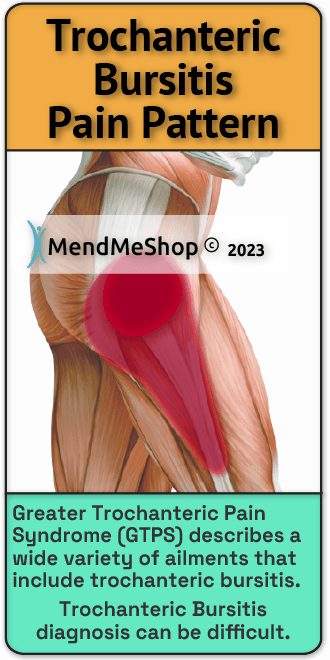
- A Blow to the Point of the Hip from falling, bumping into something or lying on the side for a lengthy period of time.
- Frequent running, or participation in sports that involve a lot of running
- Activities which require repeated hip flexion (i.e. ballet, hurdling, soccer)
- Bone spurs or calcium crystals that form in the tendons that attach to the trochanter can cause irritation
- Incorrect Posture
- Repetitive stress on the hip from running, jumping, or squatting
- An infection - most especially tuberculosis[3]
- An injury or blow to the hip or a fall on the hip
- Uneven leg length that causes excess pressure on the bursa (short leg syndrome)
- Iliotibial band syndrome (ITBS)
- Weak hip abductor muscles (gluteus medius, gluteus minimus and tensor fascia lata)
- Lumbar Osteoarthritis
- Hip and/or Knee Osteoarthritis
- Degenerative Disc Disease
- Fibromyalgia
- Flat Feet (pes planus)
- Scoliosis and other spine problems
- Other Diseases such as rheumatoid arthritis, gout, psoriasis and thyroid disease
- Prosthetic Hip Implants
GTPS affects 3 females to every male and in most cases occurs in patients between 40 and 65. Younger patients affected by GTPS are typically runners or athletes in which running activity is prevalent.
As well as the common causes of bursitis, trochanteric bursitis can occur following surgery. Patients who have undergone surgery for a hip replacement or fractured hip often complain about pain over the outside of the hip which is usually caused by irritation of the bursa. Trochanteric bursitis is also known to occur as a complication of arthroscopic surgery, although it is estimated to have a low occurrence rate (1.4% of all trochanteric bursitis cases).
Diagnosing Trochanteric Bursitis
Diagnosing trochanteric bursitis is not straightforward or simple. Why? MANY conditions (iliotibial band syndrome (ITBS), hip muscle strain, ligament sprains, etc.) have VERY similar symptoms. Your doctor will need to perform a thorough assessment and possibly run tests to determine if your pain is caused by bursitis or by muscle or joint injury, local bleeding, synovitis, arthritis, tendonitis, cellulitis or a number of other conditions.
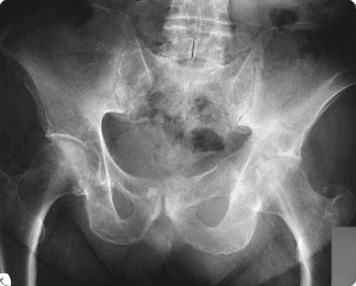
Sacroiliac joint (hip joint) dysfunction and lumbar (spine) issues are known to cause posterior hip pain. Further to this, such patients typically have a history of lower back pain. Your physician may look at such factors - especially if the patient has had symptoms persist for many months despite undergoing conservative treatments. Your physician will also try and rule out possible infection in the area for patients that have recently underwent hip surgery.
To begin with, your doctor will gather a medical history about you and your current condition and symptoms. He/she will ask about the amount pain you are having with your hip, how long you have had your symptoms and if you are experiencing a range of motion loss with the hip and knee. Details about what caused the pain in the hip, when it started, and whether or not you have ever had treatments for this or a similar condition in the past, are very helpful in assessing your injury.
Range of motion movements / tests will be done to see how much movement has been lost in the hip. You may experience some mild pain from the doctor poking and prodding at it, but by doing this the doctor will better understand the source of your pain, the level of tenderness in and around your hip, and how well your hip and knee can move with this condition.
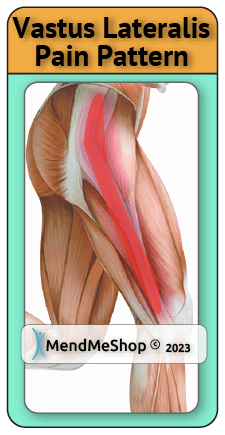
A physical examination will be performed and your doctor will visually assess and palpate (feel) the bones and soft tissue around your sore hip and the opposite joint to evaluate symmetry and recognize differences. This will identify any abnormalities, such as mild or severe inflammation, bone deformities, atrophied muscles, redness and/or warmth on the skin.
You will generally be asked to complete a series of movements to measure your active (performed by you) and passive (performed by your examiner) range of motion. These movements will test any possible, as well as your leg/hip strength, joint stability, and location of tenderness. If you feel sharp pain with both of these motions you may have hip bursitis and/or other related conditions.
Two specific tests that isolate certain conditions will be:
- Testing for pain & pain location when standing on one leg for 30 sec
- Externally rotating the hip while the physician resists the rotation.
However, both of these tests will also produce pain when if you have gluteus medius tendinopathy.
In order to rule out other conditions your doctor may recommend blood tests, an x-ray or MRI to investigate your bone structure and/or to examine the soft tissues and fluid in your hip.
Fluid Removal - Your doctor may aspirate (use a needle) to remove fluid from the bursa to check for possible staphylococcus epidermis (or staphylococcus aureus) bacterial infection. The knee and elbow tend to be the joints that are prone to septic (infectious) bursitis. If infection is detected you will be prescribed an antibiotic to treat it.
X-rays
X-rays - will provide a two-dimensional image of the overall structure of your pelvis. Although bursitis cannot be diagnosed from an X-ray, they are helpful in identifying other possible causes of pain and/or ruling out other conditions.
Some other possible causes of pain that an x-ray can identify include instability, abnormal bone shapes (bone spurs or bone cysts), wear and tear on the joints, avulsion fractures (when a fragment of bone tears away from the main bone along with the muscle, tendon, or ligament as a result of trauma), dislocations, arthritis, calcium deposits in the bursa or joint, and/or other problems. An X-Ray can help rule out alternative causes of your hip pain (ie stress fracture, osteoarthritis).[2]
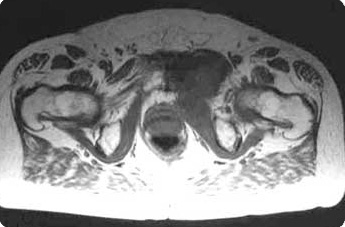
MRI Scans, CT Scans
MRI and CT Scans - Your doctor may also order an MRI (magnetic resonance imaging) or a CT (computed tomography) scan for more detailed information to help evaluate the soft tissues (bursa, muscles, tendons, ligaments, fascia, and other connective tissues) in and around your hip joint. They will show fluid next to the muscle, and may identify bursitis, tendinitis, inflammation, tears and other associated conditions. An MRI scan can confirm or rule out other hip pain-related causes, as an MRI will provide a detailed view of soft tissue in the hip. MRI scans can show damaged muscles, tendons and also detect swelling of a bursa. [2]
Diagnostic Ultrasound
Ultrasonography can confirm diagnosis and demonstrate tissue disruption or thickened tendons. It is good for identifying bursitis and excessive fluid in bursa, and/or eliminating other causes of pain. Although ultrasound is not used to diagnose hip bursitis, it can detect excess synovial fluid found in a swollen bursa.[2]
Are You Sure You Have Trochanteric Hip Bursitis?
Pain, swelling and inflammation in your hip are all symptomatic of hip bursitis. yet it is also important to consider that there are MANY other conditions that display symptoms of trochanteric bursitis. You hip is a complicated joint with 5 bones, 17 muscles, numerous tendons, ligaments and bursae connecting your leg bone (femur), pelvis and spine all together. With so many connections of tissue to the bone it's easy to see why any pain in the hip can be bursitis or some other injury in the same area. You may even have bursitis AND another hip condition at the same time. The only way you can know for sure whether you have hip bursitis is if you get a proper diagnosis for the condition by your doctor. Some other hip injuries include: hip tendonitis, snapping hip syndrome, greater trochanteric pain syndrome, hip arthritis, labral tear, osteonecrosis, or a fractured hip.
Ailments Similar to Trochanteric Hip Bursitis:
Hip Tendonitis
Hip tendonitis (tendinitis) is a condition where you experience pain, swelling and inflammation from damage or micro-tearing of one or more of the tendons in your hip. The tendons in your hip connect muscle to bone and when these tendons are injured they usually cause pain and tenderness at the front, side and back of your hip, and even into your buttocks as well. If you have hip tendonitis, you could be suffering from different kinds of tendonitis including iliotibial band (IT band) tendonitis, gluteus medius tendonitis, or hip flexor tendonitis (iliacus tendonitis or iliopsoas tendonitis). Iliopsoas tendinitis and/or bursitis are common during growth spurts when you are younger because your biomechanics are altered around the hip area. The tendons and muscles area tighten, the pelvis begins to tilt, and the rest of the lower body goes out of alignment. This can affect the lower back, hip joints, knees and your gait which can result in lower body joint issues.
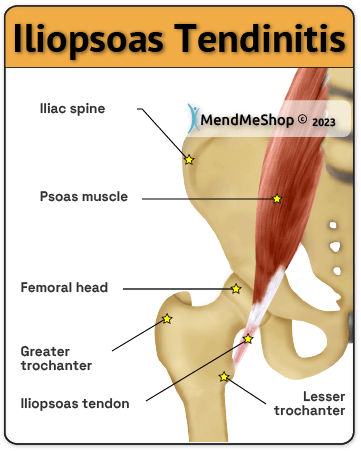
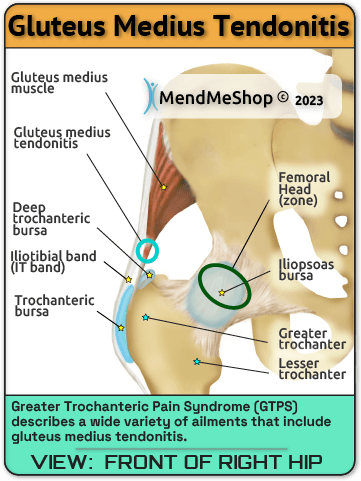
Greater Trochanteric Pain Syndrome
Greater trochanteric pain syndrome (GTPS) causes chronic pain on the side of the hip. Symptoms of GTPS include constant pain in the side hip that travels along the whole side of the thigh to the knee and occasionally below the knee and/or buttock. If you have this condition you will probably feel very specific points of tenderness on the outside of the hip.
Labral Tear
The labrum is the cartilage that surrounds the hip joint. If you have a tear in your labrum you may feel a catching sensation and pain in the hip joint, groin, stiffness and limited range of motion of your hip. Any changes or abnormalities in the physical structure of the hip can lead to a tear in the labrum cartilage.
Osteonecrosis
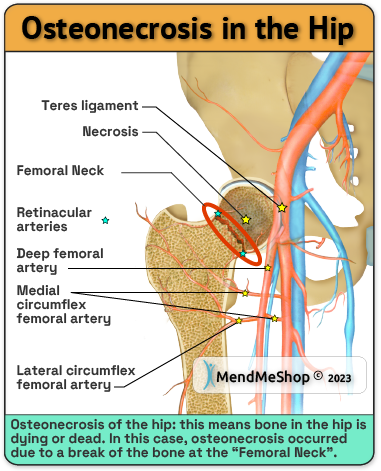
Osteonecrosis is a disease that affects blood flow to an area of bone. This lack of blood flow to the bone in the hip joint causes tissue to die inside the bone and the bone may eventually collapse. Osteonecrosis is a condition that develops in stages, general hip pain is usually felt first that may progress to a dull ache or throbbing pain in the groin or buttock area. If you have this condition you may also have more pain and find it difficult to stand and put weight on you hip. Moving your hip joint will also be painful. These stages can last anywhere from several months to over a year. Early diagnosis of this disease provides a much better outcome with consistent, proper treatment.
Fractured Hip
De-generative hip fractures are most common in elderly patients with osteoporosis. Treatment of broken hips requires surgery to either replace the broken portion or repair it with a metal plate and screws. Stress fractures of the hip are most common in athletes who participate in high-impact sports, such as long distance runners. Treatment is usually successful by avoiding the impact activities.
Hip Arthritis
Hip Arthritis is chronic form of joint pain and can be described as a dull aching pain in the groin, outer thigh, or buttocks. You may feel more pain in the morning that could get worse as the day goes but generally lessens as you get more active. Doing anything vigorous can result in pain, stiffness and may limit your movements or make walking difficult. Arthritis means inflammation of a joint and there are a number of types of arthritis of the hip - including:
- Osteoarthritis - the inflammation happens as the smooth covering (articular cartilage) on the ends of bones wears away.
- Rheumatoid Arthritis - an immune system disease that usually affects multiple joints on both sides of the body at the same time.
- Ankylosing Spondylitis - a chronic inflammation of the spine and the point where the spine meets the pelvic bone (sacroiliac joint) that can also cause inflammation in other joints
- Systemic Lupus Erythematosus - an autoimmune disease in which the body harms its own healthy tissues
Snapping Hip Syndrome
Snapping hip syndrome is when you feel a snapping sensation or hear a popping sound in your hip when you walk, get up from a chair or swing you leg around. This feeling and/or sound is made by a tendon in your hip as it moves over a bony bump. Most of the time this is more annoying than painful. However long-term snapping/popping can lead to hip bursitis, a condition that is very painful.
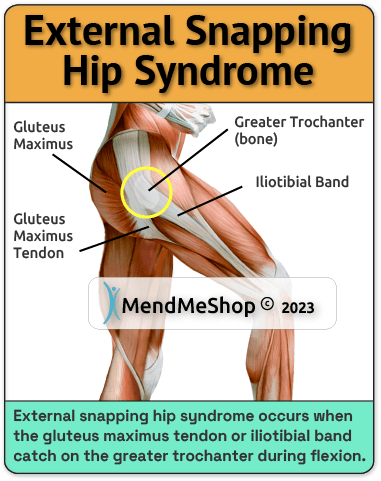
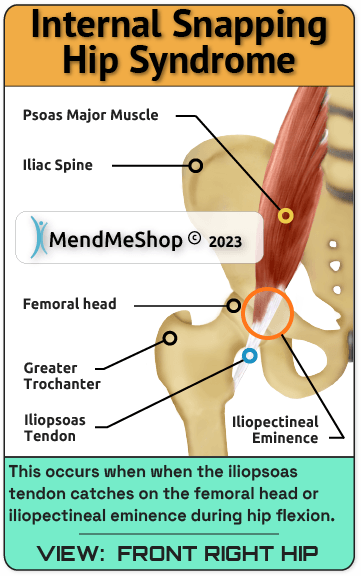
Trochanteric Bursitis: Tell Me The Risk Factors
The Biggest Risk Factors for Trochanteric Bursitis
- Being female
- Being Active (generally in running sports)
- Risk Increase with Age
A hip injury from a fall or accident also puts you at risk for this type of hip bursitis.
Lesser Risk Factors for Trochanteric Bursitis
-
Overuse - Doing the same thing over & over without adequate recovery/rest in between.
-
Spinal Conditions - There are numerous spine related conditions that can affect the way you walk (gait). An unbalanced or unusual gait can add stress to bursae and tendons in the hip.
-
Short Leg Syndrome - Differing leg lengths affect posture and gait. An unbalanced or unusual gait can add stress to bursae and tendons in the hip.
-
Arthritis - Rheumatoid arthritis is an inflammatory condition and as such can cause inflammation in tendons and bursae.
Trochanteric Bursitis Home Remedies
In the following section, we outline effective conservative treatments for Trochanteric Bursitis. If you are dealing with the more general diagnosis of GTPS (Greater Trochanteric Pain Syndrome) you will find no difference in conservative treatment recommendations.
First you need to stop the activity that is causing your pain and rest your hip. Focus on treating the symptoms of your bursitis and any other soft tissue injuries you may have in your hip. Make sure to completely reduce inflammation, tenderness and swelling-induced pain first before switching to a goal of healing your bursitis injury.
If you are suffering from an iliopsoas hip injury, your main goal should be to heal it quickly and completely while minimizing the chance of worsening your injury, or re-injuring it once it has started to get better. Obviously, a worsening injury will delay the healing process, but what's worse is that every re-injury and additional healing cycle increases the amount of time that your joint is immobilized. Time is not kind on immobilized joints - you lose strength in the joints but worse than that, you lose the range of motion in your joints due to atrophy (your flexible tendons, muscles and ligaments slowly shrink, decreasing joint elasticity). The more time that goes by with an immobile joint, the more likely you will wind up with a chronic joint problem (long term injury with persistent flare-ups). Basically it means that your hip joint will not perform as well as it once did and it becomes more prone to injury again later on.
For non-infectious bursitis, the treatment starts with non-operative options such as RICE (Rest, Ice, Compression, Elevation) has been recommended for years by doctors, trainers, and other medical professionals to treat the pain and swelling, chronic pain from injury and after any re-injury. Bursitis injuries need rest and time for the tissue to heal. If your bursitis is caused by an infection (septic bursitis), the doctor will probably drain the bursa sac with a needle and prescribe antibiotics to treat the infection. Note that a septic bursa can quickly become life threatening - this is a major reason why you should get to a doctor for diagnosis asap if you haven't already done so.
The good news is that most cases of trochanteric bursitis will heal with simple home conservative treatments and surgery is often not needed
Bursae in the hip lie deep below multiple layers of muscle and tendon; physicians and surgeons know that surgery in this are will introduce more scar tissue into the tendons, muscles and ligaments in the hip. This added scar tissue will be problematic, requiring visits to the PT and conservative treatment options post-surgery. When it comes to trochanteric bursitis there's only a few surgical options for treatment - injection or removal of the bursa sac and scraping of the bone(s) to allow more room for the new bursa to grow back. This is why surgery is almost always only performed on chronic hip bursitis cases that have not healed despite a course of treatment using conservative treatment methods.
Conservative treatment methods recommended typically include:
- Rest - This is important for initial recovery; rest and elevation will help reduce pain, swelling and inflammation in the early stages of injury. This can be difficult when you have to carry on with daily activities, but resting and elevating your hip whenever you can is recommended. During your recovery you will probably have to modify or avoid the activities that put stress on your hip until your pain and inflammation settle. However, too much rest can also be harmful, as hip immobility can cause stiffening in the joints. This is why rest should be used when reducing initial pain and swelling, but should not be considered for more long-term conservative treatment.
- Avoid Activities that Caused Your Hip Bursitis - While resting your hip it's also important to avoid all activities that may have caused your hip damage (especially any strenuous or repetitive movement). Continuing on with these activities will likely increase the severity of your injury, turning a mild to moderate case of tissue damage into a downward spiral of increasing damage that may severely impact your life later on. Also, trying to 'work around' your injury will eventually give rise to over-compensation injuries in other areas of your body (ie achilles, hip & knee pain due to your limping gait).
- Use a Cold Compress or Ice Pack - Cold is very effective at reducing pain and inflammation - use at the onset of the injury and during flareups. Immediate pain relief and reduced inflammation can also relieve some of the pressure that's being placed on your bursa although cold temporarily shortens connective tissue (tendons, muscle, fascia) causing more friction on the bursa sac. Generally, use cold when there is swelling but stop once swelling is down. In cases of chronic (long term) bursitis, there is typically little to no inflammation.
- Use a Back/Hip TShellz® Circulatory Boost Wrap - Once swelling has been reduced, you can use your own blood flow to maximize your rehabilitation. Knowing the body uses blood flow to heal soft tissue, this wrap is intended to introduce heat and an increase in blood flow to the application area; this in turn, will assist the body in its own repair process, helping decrease recovery time while reducing re-injury risk. Promoting blood flow and heat to the area will help to minimize the growth of scar tissue, increase tissue flexibility and help reduce onset of atrophy. This is why we recommend a TShellz Wrap treatment before undergoing activity - an increase in flexibility should help reduce risk of further injury while also assisting in the battle against atrophy (what we are saying is that you want to keep your joint flexible so pressure on the bursa is minimized and secondary injury risk will be reduced).
- For reducing discomfort while resting, (or to get some sleep) consider a High Quality Back Pillow and/or Knee Pillow for comfort while sleeping or sitting
- Rehabilitative Stretching under supervision of a PT or doctor. The intent of this is to provide you with increased range of motion, pain relief and strengthening of the surrounding tissue of the hip. Doctors or surgeons typically won't perform a surgery until they feel that their patient has put effort into treating the injury with conservative treatment methods. This may include up to 4 to 6 months of visits to a PT clinic. If you haven't experienced any improvement in your condition during that time then surgery may be considered.
- Stretching - Stretching your hip in PT and at home will help you to regain your range of motion much faster than not stretching at all. Stretching in many ways is key maintaining good Range of Motion (ROM) in the hip, and stretching can be made much easier with use of a TShellz Wrap® before to warm up soft tissue, and a Cold Compress or Ice Pack treatment after to prevent any return of swelling and inflammation.
Trochanteris Bursitis Recovery Stages
Hip Bursitis Home Treatment Stage 1: If the hip bursitis is very recent - use a good quality cold pack and Arnica Pain Relief Cream. If the injury has been going on for awhile, then skip to Stage 2 below.
Recommendation 1: If you are experiencing pain and swelling in the very early stages of the bursitis (first 48 to 72 hours), the first step in a conservative treatment protocol would be to focus on reducing the discomfort by applying a quality cold pack to the injured hip along with a high quality pain relief cream such as our Arnica Infusion Cream.
Note: If you are suffering from a bursitis and/or tendinitis injury that has been going on for awhile, you may not need much cold treatment as inflammation may be minimal. Anytime you are experiencing significant pain, you may find our Arnica Infusion Pain Relief Cream to be quite helpful.
Not only will you use your cold pack for the first 48 to 72 hours after the injury, but you should also use it during other stages of the healing process. Some examples include...
- after any activity that stresses the hip in a moderate way. It is wise to quickly apply cold to not only reduce the pain, but to also minimize tissue damage that may have occurred during the prior event.
- If you have a job that requires you to place some demands on your injured hip. If that is the case, use cold immediately following work and if the opportunity allows - use it for 15 to 20 minutes during lunch or another break time.
- If you are in a post-operative situation where cold compression would be utilized heavily for at least the first few weeks following the procedure. Similarly, if you are scheduled for upcoming surgery, then your doctor or surgeon might recommend undertaking cold before the surgery.
Having a Cold Compress or Ice Pack available at home to use if and when the need arises is helpful. Many of you already do so.
However, too many people over-focus on cold while ignoring the most critical aspect to healing - nourishing the injured tissues with a healthy supply of blood flow needed to repair and rebuild the injured tissues.
This leads to the most important recommendation...
Hip Bursitis Home Treatment Stage 2: Focus on Increasing Blood Flow To Injured Soft Tissue - As This is The ONLY Way It Will Heal For the Long-Term
Even though the concept is simple, improving blood flow to connective tissue in the hip can be difficult. Traditional methods require your joint to move to promote blood flow (exercise), but that same motion that promotes blood flow can at times lead to making your pain and condition worse - exacerbating your bursitis.
- Have you re-injured your hip by returning to work too quickly?
- How many times in the past have you aggravated your trochanter just trying to perform basic tasks around the home?
- Is your debilitated hip preventing you from work or activities you love to do?
Most people we deal with tell us these scenarios have happened to them many times in the past. Perhaps it has already happened to you.
Promoting blood flow within a muscle or soft tissue injury (such as bursitis) to help the body heal itself is a concept that has been utilized for centuries. This is where the focus has to be if you are seeking long-term improvement.
Oxygen and nutrients, carried within the blood, are critical for the body to heal itself. Without proper blood flow, recovering from an injury or condition will be delayed...sometimes for a very long period of time.
The real challenge is how do you promote blood flow to the hip injury site without causing further injury? This goal is further complicated by the fact the hip (and muscles controlling the hip joint) are involved in the majority of the physical movements we perform each day. Back, upper leg and hip pain can be interconnected and are often experienced in conjunction with one another. Many of the muscles that surround the hips are connected to muscles in the lower back, which in turn connect to the hamstring and elsewhere in the body.
An injury to one of these regions usually leads to straining in other areas, making an overall recovery hard to initiate. People tend to "chase the pain", meaning they only focus on treating an area that is actively painful, while not taking into account the fact they other areas of the body will be overcompensating...eventually leading to issues in those areas as well.
Now, on to recommendation number two in the journey to treat your hip bursa...
The Back-Hip TShellz Wrap® - Localized Enhanced Circulation In The Hip (and/or Back)
Once the inflammation in the hip has been reduced via a Cold Compress or Ice Pack it is time to take the next step in your treatment. Use a Hip TShellz Wrap® to improve blood flow while simultaneously helping surrounding soft tissue to become elongated and more elastic. What this means is that not only is increased blood flow helping the bursae and surrounding soft tissue to heal, the tendons/muscles/ligaments are now longer and more elastic due to the heat effect of the treatment. This, in turn, reduces pressure and friction on the bursae while simultaneously reducing the risk of atrophy (weakening of the muscles and tendons) in and around the hip. The TShellz Wrap® is a perfect tool to use at home to augment your massage and PT sessions, reduce the risk of re-injury and help keep your blood moving. Believe it or not, the best time for you to focus on avoiding re-injury and strengthening the weakened tissue is when the swelling's gone and your tissue has started to heal. It's vital that you don't go back to activities too soon because you might bring on a major setback in your recovery...
Improved blood flow helps reduce the risk of atrophy in muscles, tendons and ligaments. When you stop moving/using your hips due to pain, your muscles and other tissue can become weaker and dead tissue and toxins in the area can cause further tissue deterioration - this can lead to atrophy in the area and increase the risk of contracting more issues such as quadricep tendonitis, calf strain or achilles tendonitis. Furthermore, hip pain will increase the risk of overcompensation pain - basically the result of increased use of the feet, ankles and knees due to the change in gait (the way you walk). We have TShellz Wraps® for every major joint of the body, so if your ankles or knees are causing trouble, we can help there too!
Energy emitted from the TShellz Wraps® increases blood flow in and around the application area - we call this "LEC Response" (Localized Enhanced Circulation Response). The objective of the TShellz Wrap® is to increase blood flow in these targeted areas, resulting in relaxation of the vessel walls. The vessels then gently expand, allowing for more nutrient rich blood flow along with extra oxygen to reach the damaged tissues. Plus, the enhanced blood flow helps in flushing waste and fluid build-up from the injury site - further enhancing the ability of the body to heal.
The intention of a TShellz Wrap® is to ease pain by dilating blood vessels, decrease stiffness by elongating soft tissue, improve blood circulation, and boost metabolism and enzyme activity. In stimulating localized blood flow to damaged soft tissue, you provide needed oxygen, water and nutrients to grow strong healthy collagen. In addition, you will experience a clearing of toxins and excess fluid build up from the injury site. Over the intermediate term, this helps to reduce incidents of swelling as trapped fluids will be whisked away - reducing pressure on blood vessels.
Using the TShellz Wrap® is truly a unique experience. Within moments of applying the wrap, you can feel the sensation due to the increase in blood flow within the area. During a treatment, and for quite some time after you finish, the treated area will feel relaxed and warm. It's a very soothing sensation and extremely effective.
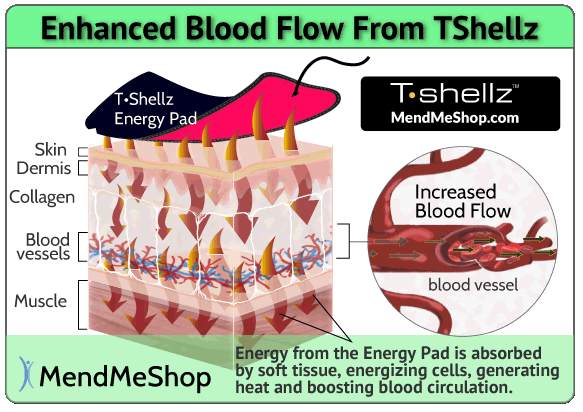
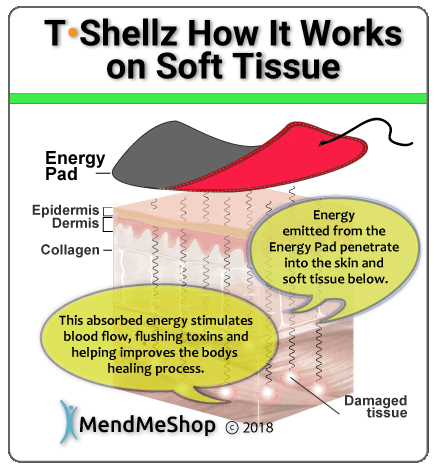
Who Should Use the Back/Hip TShellz Wrap®
We recommend the use of a Back/Hip TShellz Wrap®:
- If you have bursitis, tendinitis or other soft tissue damage in your hip (or back), then the TShellz Wrap® will provide the all-important function of boosting blood circulation where it is needed most.
- If you are dealing with soft tissue conditions affecting your range of motion.
- If you have a chronic soft tissue hip condition that has lasted for years- this device is intended to kick start the recovery process and help strengthen the surrounding and supporting tissues.
- If you are still working with a hip strain or mild tear, the TShellz Wrap® will help relax tissue in the hip prior to work and after a day at the job.
- If you are still trying to enjoy your favorite activities such as gardening, tennis, golf, etc - use the TShellz Wrap® prior to activity to help reduce risk of re-injuring or re-aggravating those targeted tissues.
- If you are suffering from bursitis and want to treat a major source of it (inflammation and damage to tissue surrounding the bursa sac). Through trauma, overuse or degenerative changes, muscle and tendons surrounding the bursa sacs will tighten and constrict. When they do, they place pressure on the bursa, causing it to become irritated. Applying a TShellz Wrap® to the area will help relax tissue in the treatment area, taking pressure off the bursa.
- If you are experiencing atrophy in the hip area and want to reduce the chance of re-injury while stretching - this is a perfect treatment to use before activity, by enhancing blood flow and elongating soft tissue.
- If you have been to a clinic for some form of massage or stretching and your PT or physician has recommended conservative treatments for home.
- If you are experiencing tightness in your muscle(s) and want to reduce the chance of re-injury while stretching - we recommend the use of a TShellz Wrap® before you stretch.
In examining thousands of pages of research, we can conclude that the TShellz Wrap® energy will produce the following results:
Effectively helps to enhance blood circulation and increase the levels of oxygen within your blood.
This improves the body's ability to eliminate toxins and other waste by-products resulting from damaged tissue within the knee. This allows the knee to more easily stimulate the self healing process.
Stimulates the production of collagen, which is a building block for human tissue.
Many knee injuries are the result of trauma to a tendon or muscle, usually causing the tissue to tear. As a result of the tear, your body triggers a natural healing process resulting in pain, inflammation, and the creation of scar tissue. This process has 3 steps; getting rid of waste while repairing damaged tissue (inflammation), fixing the torn tissue with a "band-aid" solution (remodeling), and reinforcing that band-aid solution with flexible tissue (proliferation).
You can speed your recovery while decreasing any risk of re-injuring the tissue by enhancing your body's own natural healing process. Once inflammation has been reduced, scar tissue begins to form to repair the torn tissue. Scar tissue is much faster to build than flexible tissue, but it can only repair the torn tissue temporarily. Left untreated, the scar tissue provides little flexibility increasing the risk of re-injury.
Heat will enhance the extensibility of damaged (& surrounding) tissue
This is a very important point. Many people with knee conditions often re-injure their knee due to the fact the damaged muscle or soft tissue is tight and the range of motion of the knee is restricted. Even the most minor of activities can cause a recovering knee to strain, sprain, or even tear. Every time this happens, your recovery is delayed. This is why using the TShellz Wrap® not only now, but also into the future, is wise. Heat energy emitted from the TShellz Wrap® is absorbed by tissue, gently warming it, and thereby increasing the elasticity...all without risk of causing further harm and greatly reducing your chances of re-injury.
Reduces stiffness in the knee joints.
Osteoarthritis in the knee occurs when the articular cartilage begins to degenerate. Over time, the femur (upper leg bone) rubs against the tibia (lower leg bone) with little or no protection from the articular cartilage. This lead to pain in the knee joint. The space within the joint starts to decrease without the cushioning and stiffness in the knee becomes a problem. The TShellz Wrap® excels at emitting a soothing heat, allowing for less stiffness and better range-of-motion.
Contributes to your overall well-being.
Overall, you will get the benefits of a stronger immune system and a faster ability to heal muscle and soft tissue injuries such as sprains, strains, and tissue tears. Use the TShellz Wrap® before activity to reduce risk of further injury, before bed to prevent tightness from setting in during the night, and again in the morning (when connective tissue is generally at its tightest).
Believe me when I say - words alone cannot accurately describe what the TShellz Wrap® can do for you. It truly is something you need to experience first-hand.
Directly below you will find some summarized points from Chapter 9 of "Therapeutic Heat and Cold", 4th edition*
Generally it is accepted that heat on soft tissue (muscles, tendons, ligaments) provides the following desirable therapeutic effects:
- Tissues heated to 45 degrees Celsius and then stretched exhibit a nonelastic residual elongation of about 0.5 to 0.9 percent that persists after the stretch is removed. This does not occur in these same tissues when stretched at normal tissue temperatures.
Stretching of tissue in the presence of heat would be especially valuable in working with ligaments, joint capsules, tendons, fasciae ... that have become scarred, thickened, or contracted. Such stretching at 45 degrees Celsius caused much less weakening in stretched tissues for a given elongation than a similar elongation produced at normal tissue temperatures.
Experiments cited clearly showed low-force stretching could produce significant residual elongation when heat is applied together with stretching or range-of-motion exercises. This is safer than stretching tissues at normal tissue temperatures. - Muscle spasms have long been observed to be reduced through the use of heat, be they secondary to underlying skeletal, joint, or neuropathological conditions.
- Heating muscles produces an increased blood flow level similar to that seen during exercise. Temperature elevation also produces an increased blood flow and dilation directly ... probably through direct action on their smooth muscles. The release of bradykinin, released as a consequence of sweat-gland activity, also produces increased blood flow and vasodilation.
- Increased peripheral circulation provides the transport needed to help evacuate (fluid), which can help inflammation, decrease pain, and help speed healing.
*Reference: Ed. Justus F. Lehmann, M.D., Williams, and Wilkin. "Therapeutic Heat and Cold", 4th edition
Increased Blood Circulation = Increased Healing Capability
TShellz Wraps® contain a unique Carbon Fiber Energy Pad which is flexible and will shape to conform to your body. This Energy Pad emits a uniform wave of perfectly safe energy over its entire surface. This energy is absorbed by soft tissue in the treatment area, opening blood vessels, resulting in an increase in blood flow. Increased blood circulation is what your body needs to maximize its cabability of healing soft tissue and this is why we recommend the TShellz Wrap®.
The Back/Hip TShellz Wrap® is an FDA Registered Medical Device and is suitable for use in therapeutic clinics and FROM HOME. It is completely safe for people and patients to use for themselves.
The technology found in a TShellz Wrap® has been used for decades in the worlds of professional and amateur sports - a contributing factor as to why athletes seem to recover from injuries so quickly.
Have you ever wondered by an athlete can return to activity after 4 or 5 weeks following a hip injury - while your average person takes much longer to return back to normal? The secret isn't really that much of a secret - it involves consistent treatments (meaning multiple times a day) using a treatment like the TShellz Wrap® to stimulate blood flow to the injured tissues. Most athletes have the luxury of using in-house facilities many times per day.
How many us can afford the time and money to visit a clinic multiple times a day? Very few indeed. This is how you can gain some of the advantages that athletes enjoy in their injury recovery - by using a device like the Back/Hip TShellz Wrap® two or three times a day on a consistent basis.
Consistent Treatments = Consistent And Long Term Improvement
What Else Makes the Back/Hip TShellz Wrap® So Special?
We believe the TShellz Wrap® to be one of the most effective home treatments to increase localized blood flow to soft tissue in and around the treatment area.
We can promise that you will receive a product that is designed to be safe and does what it is supposed to do... reduce pain (as stated in "Therapeutic Heat and Cold", 4th edition. - Ed. Justus F. Lehmann, M.D., Williams, and Wilkin) temporarily increase length & flexibility of soft tissue (as stated in "Therapeutic Heat and Cold", 4th edition. - Ed. Justus F. Lehmann, M.D., Williams, and Wilkin) and aid your body in recovering from tendon, muscle and other soft tissue injuries via enhanced blood flow.
The unit plugs into a standard wall outlet to get its power. The nice thing about the power supply is that the same unit can be used in North America and overseas as well. It has the capability to operate between 110v and 230v.
The TShellz Wrap® has a special signal controller that can be set for 3 different power levels of application (3=High, 2=Medium, 1=Low). The cord is long enough that you can sit or lie comfortably and watch TV, read or surf the net while you're using it.
Treatments are max 30 minutes in duration and the device can be worn over clothing. This allows you to use the device at work, at home, or really anywhere you have access to an electrical outlet.
A Quick Recap of Benefits That Can Be Achieved Via the Back/Hip TShellz Wrap®..
- Can be used ANYWHERE on the Back, Hip or Groin - very versatile
- It soothes pain and whisks away toxins
- It can be used before exercise to warm up the hip to reduce the risk of injury (heat elongates soft tissue and makes it more flexible)
- FDA Registered medical device for use in home or clinics - high quality, 1 year warranty, 60 day trial period (100% refund guaranteed)
- Increases temporary flexibility and length of tissues (reducing the re-injury factor when used before activity)
- Carbon fiber Energy Pad is strong, lightweight, and flexible - contours very easily
- A boost in blood flow helps maximize the body's ability to recover from soft tissue damage. This can be beneficial in saving time and money when associated with doctor or physio visits
- A boost in blood flow will maximize the body's ability to recover quickly. This can be beneficial in post-surgery rehabilitation, getting you back to work faster. Do not use until at least 6 weeks after surgery, and only after approval from your doctor.
When Should I Use My TShellz Wrap During the Day?
The most common question we receive from individuals prior to purchasing is - how many times a day should I be using my hip wraps and when should I be using them? While treatment plans will differ for each individual and their specific injury, there are general guidelines that should be adhered to.
- Use a Cold Compress or Ice Pack when you are experiencing inflammation (usually after exertion or movement of the injury area).
The Hip TShellz Wrap® would then be used:
- Right after rising from bed in the morning (as this is when it is most stiff)
- Prior to going to bed at night (to relax the hip, allowing for better sleep)
- Before you know you will be using your injured joint (going to work, driving, typing, etc).
Hip Bursitis Home Treatment Stage 3: - In Between Treatments With A TShellz Wrap®, Apply Our New Fast Acting Pain Relief Cream Called ARNICA INFUSION
Dealing with aches and pains affecting the foot, ankle, leg, knee, hamstring, hip, back, arm, shoulder, elbow, wrist, or hand? If so, then applying the Arnica Infusion to any of these targeted areas will bring about fast relief from the pain and sore tissues. Simply apply a small amount of cream to the body and moments later, you will experience a soothing and comforting sensation over the area.
Arnica Infusion is specially designed to relieve pain due to sore muscles and joints associated with arthritis, backaches, sprains, strains, and bruises. No matter if you are dealing with an acute injury, chronic pain, or a general "flare-up" - you will experience fast relief from pain and inflammation.
A lot of our customers asked us for pain cream, so we focused our resources and came up with what we believe to be the most effective, fast acting, topical pain relief cream you can buy without a prescription.
You are likely familiar with some of the standard topical creams on the market as most of our customers use them. They are mass marketed and even found in most department stores... Well, we are here to say that Arnica Infusion goes many steps beyond what they offer.
Made in the USA at an FDA registered manufacturing facility, you can be assured that Arnica Infusion is both safe and effective. We only source top grade ingredients while implementing strict quality control checks during every step of the production process. Expect the same high quality that MendMeShop customers have been accustomed to since we started the company in 2005.
The "Cool Blue" formula is the perfect balance between the smooth application of a cream and the effective absorbing factor of a gel. It is not too thick and not too thin - just the right texture. Best of all, it feels very nice on the skin!
Each application of Arnica Infusion feels so comforting and soothing, we are certain it will become an item you will not want to live without.
Arnica Infusion Ingredients
The Arnica Infusion formula is based on a combination of scientific research and the use of high quality ingredients. The properties within the formula were chosen for their pain relief, anti-inflammatory, and soothing qualities.
The acting ingredients within the formula include ones many of us are familiar with; along with ones that have not received a lot of publicity (only in research circles). Extensive testing resulted in a blending of ingredients that provides the most synergistic of benefits.
The notable ingredients in the Arnica Infusion formula include:
- Arnica - powerful anti-inflammatory, speeds recovery, enhances circulation
- Menthol - provides deep penetrating pain relief with a nice cooling sensation
- Vitamin B6 - promotes normal nerve function
- MSM - supports healthy connective tissues, anti-inflammatory
- Ilex Leaf Extract - increases circulation, skin conditioner
- Vitamin E - anti-inflammatory, enhances circulation, hydrates the skin
- Aloe - anti-inflammatory properties, soothes the skin
- Tea Tree - enhances penetration of ingredients
Extensive quality control procedures during the manufacturing process ensure the ingredients and final product are both safe and effective. We would not stake our reputation on anything but the best.
When Do I Apply the Arnica Infusion?
While At Work
Apply Arnica Infusion at work to help reduce acute discomfort associated with overuse of muscles and joints. No matter if you are in a physical demanding job or work within an office environment, you will be placing stress on different parts of the body and aches and pains will result.
Before Or After Work, Sports, & Activity
If you suffer from a sprained ligament, pulled muscle, strained tendon, or even bruising - apply Arnica Infusion for quick relief from the pain.
If You Are In Chronic Pain & Need To Get Some Sleep
If you have experienced this level of pain, then I don't really need to explain it. Application of Arnica Infusion can be done up to a maximum of 4 times per day on a consistent basis to help bring about substantial yet temporary relief from pains.
In-between Treatments, Limber Up With The TShellz Wrap®
Follow up your TShellz treatments with an application of Arnica Infusion. Combine the pain relieving benefits of Arnica Infusion along with the therapeutic benefits of the wraps to make your recovery go much more smoothly.
Do not apply Arnica Infusion within a 2 hour timespan before a TShellz Wrap® treatment.
Whether you decide to use the Arnica Infusion 1) on its own or, 2) in conjunction with the TShellz Wrap® and other treatments - you will not be disappointed with the results. We guarantee it!
A Note On OverCompensation
Since you are reading this, you probably know that serious hip injuries do not just disappear. Over time, it will wreak havoc on your knees and lower back due to lack of movement, over-compensation and a change in gait. It will also wreak havoc on your opposite hip side, due to overcompensation. Recovery takes a longer time for such chronic (long term) injuries, but proper healing is essential to regain strength and get you back to the activities you enjoy.
The longer your injury endures, the greater the risk of running into serious overcompensation injuries and a permanent change in gait.
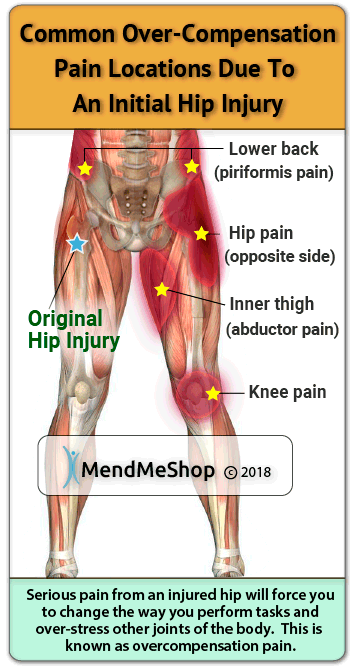
Everything in the human body is connected. An IT Band or hip bursitis injury can lead to other injuries over time if not treated properly. For example, the knee of your opposite leg may start hurting due to increased strain on it while you are trying to walk. On-going pain in this area could potentially result in long term (chronic) knee pain.
You may also over-strain your hip or lower back on the opposite, healthy side because you will automatically put more weight on your non-injured side to cope with everyday activities. When you experience pain on the opposite side of your body, this is something called "over compensation" pain.
Over time you may also change the way that you walk when your hip is hurting. If you change the way that you walk, how you get in and out of a car or even the way you climb a flight of stairs you may irritate your lower back. Usually a hip injury will happen on the dominant side (if you are right handed, this would be your right hip). When this happens there is a higher risk that you will over-strain your weaker side that is compensating for your injury.
On-going injury, chronic conditions and over compensation pain are all reasons why it is important that you remain proactive in your recovery. This is why it's also critical to completely heal your hip before returning to activity. If you don't focus on healing your injury quickly and completely you run the risk of interrupting your lifestyle in a major way.
To Stop Re-Injury & Reduce the Risk of a More Serious Overcompensation Injury, You Need to Heal Quickly & Completely!
Anyone in need of rapid recovery and complete healing must consider a comprehensive treatment plan that includes an effective means to minimize swelling and inflammation yet also stimulate healing and tissue elasticity. We have found no better set of tools that can be used at home than this:
Conservative Treatment Tools Our Clients Have Used to Help Limit Damage & Boost The Body's Soft Tissue Repair Process to the Hip at Home:
- A Cold Compress or Ice Pack to reduce inflammation wherever there is pain and/or swelling (as soon as possible).
- A Hip/Back TShellz Wrap® to increase blood-flow to the treatment area (a Localized Enhanced Circulatory Response® Treatment).
- MendMeShop Arnica Pain Cream for temporary relief of pain due to sore muscles and joints.
- A High Quality Back Pillow if you are experiencing discomfort when sitting or relaxing.
- An Exercise & Stretching Plan to prevent muscle atrophy and shortened tendons in the Knee joint. A proper plan will increase elasticity and strengthen the muscles and tendons in the hip, knee, and ankle.
Conservative treatment tools just like these have been used successfully by thousands of hip injury sufferers - just like you.
The TShellz Wrap®: Intended to Enhance Blood Flow in the Treatment Area
We believe the use of TShellz® Circulatory Boost Wraps for boosting blood flow to soft tissue in the area of application is one of the most under-utilized home treatment options available on the market today. We have client after client that have tried many options out there and have been amazed at how effective and fast the TShellz Wrap treatment helped relieve their pain while increasing blood flow in the knee.
Increased Blood Flow Stimulates the Bodys' Ability to Heal
With regular use of the Hip TShellz® Circulatory Boost Wrap:
- Your pain will be reduced*.
- Due to increased blood flow, soft tissue in the treatment area on the knee will be expected to recover at an accelerated rate with reduced potential for re-injury*.
- Tissue in the treated area should experience a larger range of motion and increased extensibility of collagen tissue* due to the heat effect on soft tissue. This should translate into a reduced rate of re-injury occurrence as soft tissue is known to lengthen and become more flexible when exposed to warm temperature. (*Chapter 9 of "Therapeutic Heat and Cold", 4th edition. - Ed. Justus F. Lehmann, M.D., Williams, and Wilkin)
*Know that every personal soft tissue injury is unique and the TShellz Wrap may not work for everyone. This is why we offer a 60-day money back return on all our TShellz Wrap devices.
Scar Tissue & Fibrotic Adhesions
All connective tissue is living tissue; tissue requires a blood supply and is continually in a state of regeneration. Any and all connective tissue has the potential for injury and inflammation. Injuries can be small such as in the case of a strain, or injuries can be large tears or even avulsions (complete tearing). Once an injury is experienced, the area will experience both inflammation and the growth of scar tissue (otherwise known as adhesions).
The occurrence of scar tissue is a regular part of life. Scar tissue forms as part of the progression after injury occurs. Scar tissue essentially 'fills in the gaps' after a cut, tear or wound presents itself in the body. Scar tissue is composed of the protein, collagen; it is widely known in the medical community that scar tissue is weaker and less flexible than original tissue.
- Normal/original connective tissue is made up of collagen, but this collagen is aligned in a specific direction with each strand in alignment. This results in the connective tissue having a strong tensile strength while also having excellent flexibility and extensibility.
- Scar tissue is made up of a 'criss cross/ random' formation of collagen and attaches to everything in the area. You can likely imagine the result of a patch of scar tissue; the effect is similar to pouring extremely sticky glue in your hair. It interrupts everything and is disruptive to the function of the connective tissue. The caveat is that the scar tissue does its job - it binds tears together. You definitely want the tear to heal, but it is important to ensure the scar tissue goes away despite the fact that it does not go away easily.
- After scar tissue forms, although the wound or cut is now closed (and less prone to infection), the area of tissue itself is inferior in functionality to what it replaced.
Continuous re-injury and build-up of scar tissue makes it more likely that you will wind up with chronic pain, reduced Range of Motion or even arthritis (permanent damage).
Heal Quickly to Minimize Scar Tissue Growth & Reduce Re-Injury Risk
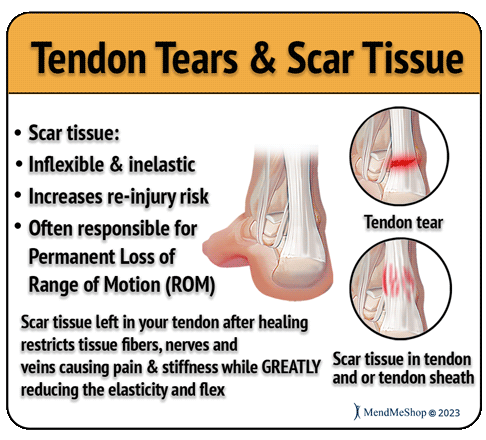
The human body will use scar tissue as a temporary solution and will try to build the scar tissue as fast as possible to heal tears in soft tissue (muscles, tendons). Scar tissue can form fast to bring together the edges of a tear, but working fast doesn't mean that the job's done right. When scar tissue forms it doesn't come together as neatly as regular (healthy) tendon/ligament tissue would. Scar tissue fibers will lay down over top of your tear in a cluttered, messy and jumbled up way.
This is how scar tissue works - it is messy and inelastic. The scar tissue that forms in your soft tissue will be unorganized and won't line up properly with the healthy tissue surrounding the tear. This scar tissue will attach to everything in and around the tear including the surrounding healthy tissue as well. This results in a long-term fusing together of everything the scar tissue touches, reducing your ability to move and making the injury even more painful!
For soft tissue injuries (tendons, muscles, ligaments, fascia), it is important to heal quickly and completely; this will help minimize the build up of scar tissue. If you don't, your tissue injury may be the start of a long term chronic injury resulting in a loss of Range of Motion and joint atrophy.
The longer a soft tissue injury remains, the more scar tissue is likely to build up in and around the injury location. This is why it is critical to treat your injury quickly without delay. Continuous re-injury and build-up of scar tissue while staying active or going back to work means you will experience a greater risk of winding up with on-going, chronic foot pain and overcompensation injuries to the hips, knee(s), and or back.
Surgery, Post-Surgery Rehabilitation and Hip Exercises
If you have undergone surgery on your hip (reattachment, repair, graft, bursectomy, debridement, etc) and are looking for rehabilitation information, here is a link to our post surgery recovery page.
Increasing flexibility and strength in the hip is a key component to speed healing and avoid re-injury. For this reason, we have created ebooks that outline specific exercises / stretches for our clients undergoing hip rehabilitation. Even when you're injured and in pain you need to keep moving to break-up scar tissue that's forming in tendons and ligaments within the hip. Regular movement can increase healthy range of motion (ROM) of your joint, guaranteeing you a speedier recovery process and return to regular activities.
However, moving when you're injured is hard. Since moving while injured can be painful most people think it's better to stop moving, rest their hip and hope that their injury will heal all on its' own. Even though rest is important to recovery, too much rest during the recovery process will increase the amount of scar tissue in the joint.
Circulatory Boost treatments combined with a proper stretching regimen will help decrease proliferation of scar tissue while increasing elasticity and strength in the hip joint and surrounding connective tissue.
During the healing process your body will fill in soft tissue tears with dense, brittle tissue called "scar tissue". The human body will use scar tissue as a temporary solution and will try to build the scar tissue as fast as possible to heal tears in the soft tissue. Scar tissue can form fast to bring together the edges of a tear, but working fast doesn't mean that the job's done right. When scar tissue forms it doesn't come together as neatly as regular (healthy) tendon/ligament tissue would. Scar tissue fibers will lay down over top of your tear in a cluttered, messy and jumbled up way.
Atrophy is arguably a bigger issue than scar tissue although they are closely related... Whether you have a hip strain or have recently had an operation in the area, you will find that the joint has a more limited range of motion than you had before. In most cases, this is due to atrophy - the shortening of connective tissue in the hip and knee due to inactivity. In cases where atrophy exists, it becomes increasingly important to stretch and do gentle exercise to combat atrophy before it becomes a chronic (long-lasting) issue. If you are currently recovering from a hip injury speak with your physician about stretches and exercise.
When done properly under recommendation of a physician, stretches have a proven track record of assisting in the speedy recovery of many patients. This is without doubt, the final essential tool for complete recovery. Once a patient deals with the swelling and inflammation through use of a Cold Compress or Ice Pack, then begins the Circulatory Boost process by using home treatment with the TShellz Wrap, while resting to keep stress off the injury. Once the injury has healed, it is time to take the third and final step to recovery by beginning a rehabilitation stretching regimen.
When making the transition to crutches, PTs often prescribe gentle stretching of an injured hip, especially if your are recovering from a particularly invasive surgery (ie reattachment, graft). They don't prescribe this to annoy you - it is in fact the most important part of injury recovery. By choosing to ignore recovery recommendations (ie. not stretching), there is a substantial risk of re-injury or even sustaining an injury greater than the original injury ever was. In some cases, your hip may never fully recover.

Consistent stretching (as prescribed by your physician or PT) not only helps minimize the growth of scar tissue, but it also increases the elasticity and strength of the hip joint and interconnected soft tissue. Stretching, when used in conjunction with the Hip TShellz® Circulatory Boost Wrap will allow you to be better prepared to handle higher and higher loads. Eventually you will reach a stage where your hip can handle standing or walking for longer and longer periods of time. This is the final stage of recovery and depending on age, the nature of the injury, your weight and many other factors, it can take the longest time to complete. But remember, for injuries to major joints, it pays to be patient! Rushing your recovery almost never pays as it exposes you to increased risk of re-injury.
If you are having surgery sometime in the future, know that rehabilitation at-home while attending regular PT or doctor appointments is vital for your overall recovery. Consistent exercise and conservative treatment on a daily basis during your rehabilitation while working with your doctor or physical therapist is key. This is why you should seriously consider maximizing your recovery by using the TShellz Wrap® at home once you are approved for PT.
The more consistent you work at enhancing blood flow to surgically repaired soft tissue, the more consistent the healing process will be. Nourishing the tissues will more oxygen and nutrients (which are carried through the blood stream) will give the body a better ability to produce new, healthy collagen. In effect, you will help the body produce stronger tissues while potentially reducing the number of setbacks that can occur following surgical procedures.
Key Points To Keep in Mind When Treating Bursitis, Tendonitis & Other Connective Tissue Injuries In The Hip
1: Make Sure That Complete Healing is Your #1 Goal
We all know that if the injury was healed, the pain would go away but what about the opposite situation? If the pain is gone, does that mean the injury is better? Unfortunately, this is not always true.
Too many people only focus on suppressing pain symptoms while providing less attention to the true healing aspects of the body. Experiencing less pain, while obviously a good short-term goal, never equates to underlying healing. Scar tissue can remain for months after one gets to a point of being relatively pain-free. However, as long the weak and brittle scar tissue remains, you are susceptible to re-injury or re-aggravation. Certain motions or movements can cause the weaker tissue to easily tear - resulting in some reversal of the recovery up until that point.
This is why we recommend for people to continue with their doctor or therapist recommended exercises and to continue with mild treatments of the TShellz Wrap® for a period of time - to better ensure complete healing.
Ongoing treatments to enhance circulation will soothe, relax and help promote a healthy recovery of your damaged hip muscles and tendons. Back/Hip T•Shellz treatments will also allow your soft tissue to extend further due to the deep warming sensation created by the enhanced circulation to the treatment area. The more extensible your tissues are, the less likely they are to strain or sprain.
Soft tissue injuries are a race against time. The faster and stronger you heal tissue in your hip, the less chance there is for re-injury or other problems (such as overcompensation injuries) later on.
2: Resting Your Hip Will Help, But Only Temporarily
People tell us all the time, "I was told that if I stay off my feet for a few weeks, my hip pain will disappear for good." The truth is, it is easy to let knee pain keep you in bed or on the couch for a very long time. The problem is, if you keep your knee(s) inactive, atrophy will quickly compound the issue. As the muscles, tendons and ligaments in your knees and lower legs shorten and weaken, you will quickly find that your knee will feel unstable when you do use it; you will be much more likely to strain your knee or pull a calf muscle and your knee range of motion will be greatly reduced.
It may take weeks or months for atrophy issues to surface, but when they do, merely resting will not solve the underlying issues. You need to utilize options that will combat atrophy, treat the source of pain and keep soft tissue flexible and healthy as possible.
Resting has a role to play, but it is only one small factor in a recovery plan.
3: Identify What is Causing Your Hip Problem & Fix It. Otherwise, It May Come Back
In order to get lasting relief, you need to identify all the factors that are contributing to your hip pain. An example of some factors that may or may not be relevant are:
- muscle imbalances
- pinched nerve(s) in the knee, ankle, hip or lower back (ie. sciatica)
- short leg syndrome
- obesity
- flat footedness
- hip arthritis
- trauma
- chronic knee problem(s)
A huge number of people who contact us are unsure about the true causes of their discomfort. It really goes to show how important it is to get a proper diagnosis from your physician and get to the root cause. To really deal with a injury, you have to know the injury is - so get to the doctor and find out.
4: Know that Hip Pain isn't the Only Proof You're Still Injured

Would you know you injured yourself if there was no pain? Probably not! Pain and swelling perform a useful role in letting you know that you did, in fact, injure yourself. Pain and swelling are what get you to seek out medical attention in the hopes of finding a way to reduce the pain and heal your injury.
Hip bursitis is capable of causing extreme pain. Modern medicine is often quite successful at pain suppression and this is truly a great gift - however, too many people only focus on suppressing pain symptoms while providing less attention to what is occurring in their hip joint. Be careful with pain-killers that mask the pain as overuse can give you a false sense that your injury is gone. Strive to reduce the inflammation and maintain or even improve flexibility in the hip while avoiding re-injury to see a reduction in pain.
On-going TShellz Wrap® treatments at home, every day, are intended soothe, relax and promote blood flow to connnective tissue. Consistent TShellz® Circulatory Boost Wrap treatments before activity or work will help warm up the area, increasing soft tissue elasticity & flexibility; this in turn will also reduce the risk of re-injury.

MendMeShop Arnica Infusion Pain Relief Cream
Pain Keeping You Awake?
Pain Keeping You In Bed?
Pain Got You On Edge?
Temporary Relief from Serious Pain For People Who Are Serious About It!

MendMeShop Hip/Back TShellz Wrap®
This wrap is designed to:
- increase extensibility & flexibility of muscles in the back during treatment & for a short while after
- increase blood flow in the application area
- be used on the upper back, lower back, hips, chest & abdomen
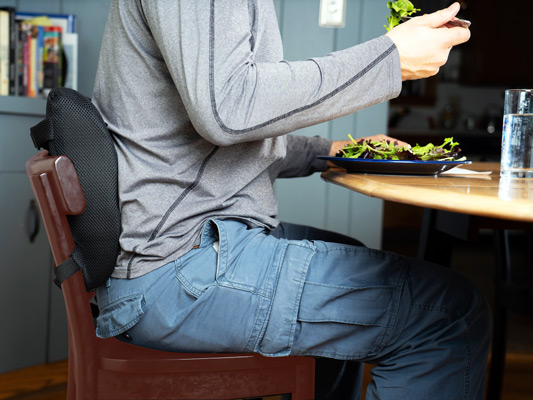
MendMeShop's Back Pillow / Lumbar Support
This is by far the best knee pillow we have ever tried
- Perfect Size & Shape
- Not too Soft or Hard
- Removable, Washable Cover
- Multiple uses: I use it often between neck and shoulder when reading in bed.
We Receive Calls All the Time From Customers Who Simply Want To Thank Us For Introducing Them To Our Amazing Products!
Let me tell you, we appreciate all the feedback we have received over the years. We have had many medical professionals, athletes and everyday people call and write to tell us about their positive experiences with our devices and the company in general. It never gets old hearing about the successes and it provides us with the motivation to continue doing what we do best - provide individuals with options to heal from the comfort of their own home.
A SMALL Sample of Feedback From Our Customers
-
USACharlie
The Best Service by Far!
The service from the Mend Me Shop is by far the best you could ever hope for. I have spoken to Paul on numerous occasions and his knowledge is very much appreciated. Do not hesitate to order from this company. Their products are made well and work. Their customer service is the best you could ever hope for. -
USAD. McBride
I have called the office and received helpful guidance. Really appreciate the help and so glad I found your products!
-
USAL. Anderson
Thank you, too, for the personal attention to your customers. A rarity, in today's world!
-
USAT. Kienlen
You guys are tremendous. I was overwhelmed by your speed and thoroughness regarding my problem.
-
USAM. Callahan
The fact that you guys are there for us every step of the way matters as well. Your company is wonderful and that's a rarity these days.
-
USAD. Hunzicker
Thank You so much superior service as well as unprecedented guarantee.
-
USAP. King
The cost seemed minimal compared to what I had already spent at the doctor and physical therapist.
If you're tired of being told that resting, drugs and surgery are the only answers to your soft tissue injury.... Be optimistic, because there are effective alternatives for you.
The Reasons For Our High Success Rate - Our Customers!
We never claim our products will work for everyone. That is simply impossible to achieve. Everyone has a different capacity for healing and different circumstances behind their injuries and/or conditions.
In addition, some people may have a hard time sticking with recommended protocol in order to achieve benefits from our devices. Quite simply, our clients that have had successful outcomes have made a small effort to invest 60 minutes a day into the program. If you do the same, chances are you will be very happy with the outcome.
Support Available During Treatment and Beyond
Right after you place an order, email us and we will have a plan developed immediately so you will be able to get started upon arrival of your parcel. We can't promise you miraculous results, however, we do promise to do everything we can to help you with your condition.
Everything you have read up to now has hopefully given you some hope.
However, words are meaningless unless a company stands strongly behind the products they sell. This is what sets us apart from others...we offer people a comprehensive, 60 day, full 100% money back guarantee. We take on all of the risk because we know our products work well for the overwhelming majority of people who purchase them.
We Will Support You Every Step of the Way
You are never alone when making a purchase from us. When we say we stand behind our products, we truly mean it!
If any question or concern arises, simply send us an email at any time (we check our emails constantly all throughout the day and night - even on holidays!). We will respond as soon as possible.
Simply call toll free 1-866-237-9608 to place an order with one of our knowledgeable Product Advisers. They have the ability to answer all your questions...ensuring you only receive the products you need.
Product Advisors are available 9:00 am to 5:00 pm Eastern Standard Time Monday to Friday.
North America Toll Free 1-866-237-9608
Outside North America +1-705-532-1671
We Stand Behind All Our Promises With An Iron-Clad Guarantee
-
1Guarantee #1
Use your products diligently for up to 60 days and you will experience a significant reduction in pain. If not, I encourage you to send back the items for a no-hassle 100% refund.
-
2Guarantee #2
You will not be left in the dark after purchasing any product from us. AidMyBursa Advisors and Product Specialists are available 9:00 am to 5:00 pm Eastern Standard Time Monday to Friday.
-
3Guarantee #3
Your order is guaranteed to be shipped within 24 hours on every business day.
-
4Guarantee #4
All purchases receive a one year, full replacement warranty with guaranteed, prompt service.
-
5Guarantee #5
You could save hundreds of dollars and possibly more, by getting back to work sooner.
We Can Get You Started For Less Than The Cost Of A Few Physio Sessions
Think about it – you can now have the ability to treat your pain from the comfort of your own home while saving money in the process.
Best of all, you are fully protected when making a purchase from us as we offer a no-hassle 60 day, full money back guarantee.
The Next Step Is Up To You!
Living with pain is never easy as it affects your entire lifestyle. Nothing is more important than making the proper decision when it comes to treating your muscle injury. Most methods only mask the problems or provide temporary relief; they do not treat the pain at its source.
AidMyBursa stands out in this regard as our goal is to help you heal for the longer-term.
The bottom line is, you are welcome to try our products for a full 2 months. If you do not receive the benefits that others have experienced after using the product as directed, simply call us to initiate a return and we will issue a prompt & full refund. There will be no hassle and no hard feelings.
The fastest option you have to get our product into your hands as soon as possible is by placing your order online - at this very moment..
Or, Call Our Office. We are open Monday to Friday to allow you place an order over the phone. Simply call toll free 1-866-237-9608 to place an order with one of our knowledgeable Product Advisors. They have the ability to answer all your questions...ensuring you only receive the products you need.
North America Toll Free 1-866-237-9608
Outside North America +1-705-532-1671
If you choose to order through our online shop, know that we keep no credit card data on file. Once the transaction is completed, the credit information disappears from our internal systems.
As you can see, ordering from us is a very easy and safe process, no matter if choosing to order on-line or over the phone.
Are you still unsure about placing an order? let me address some questions that may causing some hesitation...
What is the success rate of the TShellz Wraps®? Do they really work?
We try and keep in touch with a large percentage of our customers, and we encourage them to do the same. In doing so, we have received a lot of feedback as we have been in the business since 2008.
We can say that the return rate on our products is only around 5 to 10% any given month. That is exceptional by anyone's standards. Therefore, we can safely indicate that the overwhelming majority of people who purchase from us do achieve benefits with our products.
How much time do I need to dedicate for treatments? Are the products easy to use?
The TShellz Wraps® are very easy devices to use. After one or two uses, you will engage in the treatments with ease. Very detailed instructions are included and you are always welcome to contact us by phone or email if the need for help arises.
In regards to the TShellz Wrap®, it is ideal to use the device two or three times a day on average. Each treatment session is a maximum of 20 minutes in duration and the device will turn off automatically at that time. Typically, people use the TShellz Wrap® before bed, upon awakening (or not long after) and one other time during the day when the opportunity presents itself. For people in an office setting, many will use the device at work (as it can be worn over clothing). For others, they will use the device an our or two after work.
A Cold Compress or Ice Pack is primarily used following activity that stresses the injured tissues (following work, after a sports activity, or just suffering a general re-injury). This is done to reduce inflammation and to minimize tissue damage. Treatments are 15 to 20 minutes in duration.
How long has MendMeShop been in business
We established our firm in December of 2005. Our track record in this field continues to grow and we plan on being around for many decades to come.
What is your return policy? Is it the standard 30 days?
We go above and beyond what other companies offer - we offer a full 60 day money back guarantee with no restocking fees.
AidMyBursa advisors do not work on commission, so be assured you will only receive fair and objective information.
Continue with your recovery by resting your bursitis afflicted joint. Limit the activities that may aggravate your condition. Without proper rest and limitation on activities, being active as if your joint is healthy can lead to re-injury. To get back to doing the things you love, you need to give your body proper care and attention.
The trick to healing your injury and getting your joint back in the best possible condition you can is getting it to heal with minimal scar tissue. Even with optimum healing, there is always less elasticity in previously injured tendons, muscles and ligaments. However, if you heal your tissue properly and minimize scar tissue build up, your chance of getting a re-injury or incurring a long term case of bursitis is much lower than average.
The TShellz Wraps® are intended to help minimize scar tissue growth. The combination of heat and increased blood flow can have a very positive effect on soft tissue, as soft tissue is known to elongate and increase in flexibility due to heat*. Increased blood flow means that tissue can repair more easily due to the increased flow of oxygen and nutrients through your bloodstream.
* Chapter 9 of "Therapeutic Heat and Cold", 4th edition. Ed. Justus F. Lehmann, M.D., Williams, and Wilkin.
Although steroid injections may provide temporary relief from the pain of tendinitis, bursitis, or other soft tissue injuries, they should be considered carefully as they can weaken soft tissue and possibly increase risk of rupture. If you do opt for an injection, doctors usually recommend that you do not participate in strenuous activities for several weeks to reduce the risk of a rupture.
Would you like to see an example of how we go the extra mile in helping customers?
Read this incredible letter we received from Vicki Wilkins, an individual who spent over a decade dealing with hip pain. I will let the letter speak for itself.
Dear Paul,
In your last e-mail to me you made a very profound statement that I had never heard before. I have been to several doctors over the past 10 years and not any one of them ever told me that snapping hip syndrome was a manifestation of short leg syndrome. I truly think that many of my problems are layers that have had to have been slowly peeled away to find out what the problem is that is causing each and every one of them. I thought about the statement that you made and I applied it.
Several years back I had a chiropractor tell me that I had short leg syndrome and that I had fallen arches in my right foot and leg. He ordered me an orthotic and a lift to make up the difference. My foot hurt all the time and my right hip hurt all the time and so I stopped wearing them...
No Doctor knew what to do for me and basically tried to give me pain medication to cover it up. I don't want to cover anything up. I want to find the root of the problem and treat it. So, I got to thinking about your statement. (I know it seems like I am going around this same tree, but I will get there)... I am telling you, that one little statement you made took care of my bursitis and my snapping hip syndrome. I am no longer suffering from any of that and I am sleeping well at night.
Thank you for your statement. You just don't know how much that has meant to me. You don't know me, you have never met me but you literally saved the quality of my life. It took me a few days after I read your e-mail to put two and two together so to speak but it was worth trying again.
Thank you so much.
Vicki Wilkins
AidMyBursa advisors do not work on commission, so be assured you will only receive fair and objective information.
Product specialists are available 9:00 am to 5:00 pm Eastern Standard Time Monday to Friday.
If any question or concern arises, call us or simply send us an email at any time (we check our emails constantly all throughout the day and night.. even on holidays!). We will respond as soon as possible.
North America Toll Free 1-866-237-9608
Outside North America +1-705-532-1671
FREE SHIPPING ON ALL PRODUCTS CURRENTLY ENABLED
Please be aware that this information is neither intended nor implied to be a substitute for professional medical advice. All testimonials and comments reflect the real life experiences of individuals that used our products, however, individual results may vary. Always seek the advice of your physician or other qualified health provider before using any of our outstanding products to make sure they are right for you and your condition or if you have any questions regarding a medical condition.
For more information, call us via: 1-866-237-9608 or send us an email. View our Privacy Policy.
The terms Inferno Wrap®, Freezie Wrap®, T-Shellz® and Mendmeshop.com® are registered trademarks of In.Genu Design Group Inc.
All images shown are exclusive Copyright© 2006 - 2025 AidMyBursa.com.
Sources:
1. (2023) 3 Interesting facts about Hip/Trochanteric Bursitis | Sports Injury Physio. Retrieved May 30, 2023, from https://www.sports-injury-physio.com/post/3-interesting-facts-about-hip-trochanteric-bursitis
2. Orthopedic Specialists of SW Florida. How Is Hip Bursitis Diagnosed?. https://www.osswf.com/blog/how-is-hip-bursitis-diagnosed. Updated May 30, 2023. Accessed May 30, 2023.
3. "Trochanteric Bursitis Treatment | Hip Pain Relief | Pain Spa, Bristol, UK". 2019. Pain Spa. Accessed March 15 2019. link
4. UPMC Sports Medicine. (2023) Trochanteric Bursitis Causes, Symptoms, and Treatments | UPMC. Retrieved May 30, 2023, from https://www.upmc.com/services/sports-medicine/conditions/trochanteric-bursitis